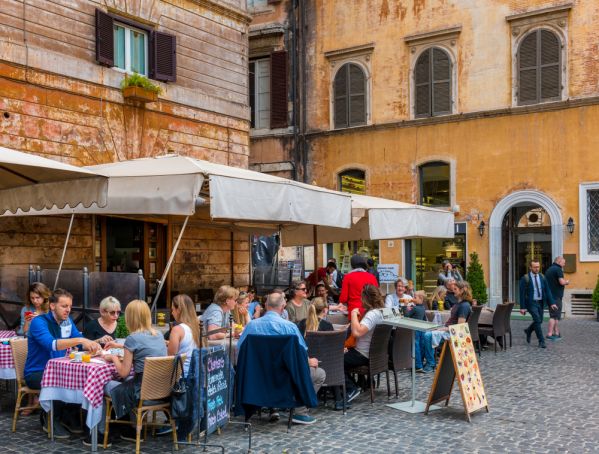Rome extends availablity of outdoor restaurant tables
Rome needs to rethink outdoor dining tables
To meet the needs of restaurant operators, surfaces, umbrellas and chairs have invaded meters and meters of public space, changing the face of the city.
In some cases, restaurants have tripled their outdoor space, occupying extraordinary locations. But they were meant to be just a temporary solution, bound to the state of emergency. What happens now that the state of the health emergency is over?
What is the situation Rome’s inhabitants are facing?
The only thing we know for sure right now is that they will remain, as they are today, at least until the end of the year.
We’re talking about the outdoor tables granted to all premises that administer food and beverages, built-in as a tool to combat crisis and, quickly, turned into a kind of casbah without rules or with rules definitely not respected.
They have occupied roadsides, often legally taking away parking spaces. We see them made out of wooden pallets, wrought iron, more or less decorated and more or less basic.
For the restaurant industry, they have been instrumental in restarting the system after the 2020 quarantine related closure. But now they require discipline: the health emergency is over, the economic and commercial one isn’t yet.
Yesterday afternoon, the Councilor for Productive Activities, Monica Lucarelli, and the one for Mobility, Eugenio Patané met at the Department of Commerce. The Capitoline Superintendence and the General Commander of the Local Police were at the table. Representatives of the Department of Culture and the President of the Trade Commission were also in attendance, together with various trade associations.
However, we are still at the preliminary scuffles. A new operational meeting is scheduled to start drawing up a concrete plan, after Easter of course. At the moment, one certainty is that the current concessions will be extended until the end of the year, with what the commerce department defines as a bridge measure.
How will the rules change for outdoor seating areas?

Photo credit: Boris-B / Shutterstock.com
The stated objective, though, is to regulate the entire system. This means standardizing the types of furniture in terms of materials to be used and the colors.
In short, putting a stop to the melting pot made of plastic curtains covering wooden or wrought iron planks. The Capitoline Superintendence was present at the table for this reason, and will have to dictate the aesthetic elements to be included in the new outside spaces.
Then there is the problem of all problems: the size and regulation of outdoor seating areas.
Even before the pandemic, Roman chronicles have been abundantly fed by blitzes of the traffic police who seized tables and chairs of pizzerias and restaurants. The next day restaurants put them back on the street again, so much so that, by force of their seizing, the local police depots have been filled several times over.
The idea that hovers around the Department is to provide each exterior space with a QR code - that little square made up of black modules arranged in a white pattern - which would make all necessary information immediately available to regulators.
Only, in addition to creating this code, it is also necessary to make it readable on the handhelds and cell phones of the Municipal Police.
What will happen to Rome’s streets?
The third problem to be faced between now and the end of the year will be that of reviewing the classification of some roads that are today considered to be highly viable and, therefore, subject to certain limitations in the concession of spaces for the creation of terraces.
Councillor Lucarelli explains: "In order to get the go-ahead from the Council it is necessary to address some key issues. Among these, it is important to underline the solution requested by Councilor Patanè to revise some points of the General Plan of Urban Traffic and to downgrade some roads that are currently part of the main road system, and therefore not subject to the installation of outdoor platforms and tables, to ordinary road systems.
I have asked the associations to provide me with a detailed list of streets that will have to change their classification, so that we can carry out quick and targeted work done by professionals".
Photo credit: Daniele COSSU / Shutterstock.com




















